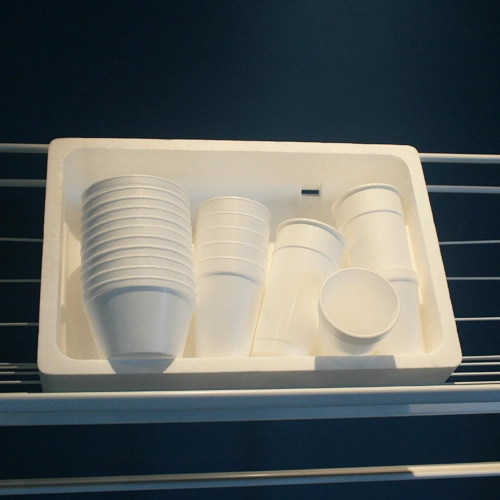Expanded Polystyrene (EPS) plays a big role in building, packing, and factory uses. It gives great warmth and stays light. But people need to know how EPS acts in a fire. This helps keep things safe. Normal EPS has some fire dangers. Yet, fire retardant polystyrene has changed its safety level a lot. Now it fits tough jobs where fire protection matters most.

EPS Behavior When Exposed to Fire
People must grasp the basic fire traits of EPS. This guides smart choices for its many uses.
Combustion Traits of Normal EPS
Plain EPS can burn. It may help flames move if no retardants are added. Heat makes it soften, shrink, and melt. It can let out gases that catch fire. These gases speed up the blaze. Fire starts between 350°C and 400°C in some cases. So, it faces risks in usual fire events.
The burning steps for plain EPS include breaking down the plastic by heat. This lets out gases that keep the fire going. Because of this, untreated EPS does not work well where fire safety comes first. This includes house building and careful packing jobs.
Things That Affect Fire Reaction in EPS Items
Many points decide how EPS reacts in a fire. Thickness, density, and surface size change when it catches and burns. Low-density stuff often spreads flames quicker. It has more air inside. Thick parts might shield themselves a bit. Big surfaces give more spots for fire to start.
Air flow and nearby items can speed up or slow the fire a lot. Little air may cut oxygen and slow burning. Good air flow can make the fire grow fast. Items around that burn can create loops. These loops make the whole fire worse quicker.
Add-ons like fire blockers change the fire score of EPS goods greatly. Such chemical tweaks put off starting the fire. They cut how fast flames move. And they lower bad gas release when burning happens.
Role of Fire Retardant Polystyrene in Boosting Safety
Fire blocker tech has turned EPS from easy-to-burn stuff into a safer choice. It works for key jobs now.
Ways Flame Blockers Work in EPS
Flame blockers stop the burning process. They do this by heat shields or gas stoppers. These ways make walls that block heat from reaching the plastic below. Or they send out stuff that breaks the burn chemistry in the air over the surface.
Usual blockers include ones with halogens, ones with phosphorus, and growing graphite. Each kind brings different pluses. It depends on the job needs and green concerns.
Compare Normal EPS and Fire Retardant EPS
Fire retardant EPS shows much better safety marks than plain kinds. It waits longer to catch fire. And it slows flame movement. This gives extra time to get out and put out the fire. Plus, it makes less smoke and bad gases when burning. So, it cuts health risks from fire contact.
F-flame retardant grade has passed the United States Safety Testing Lab (UL) check. The paper number is E360952. This check proves it meets hard safety rules for flame-blocker uses.
Types of Fire Retardant Polystyrene Kinds
Many fire retardant EPS kinds let people pick the right one. They fit different jobs and safety rules.
Common Grade vs Flame Retardant Grade EPS
Common grade fits low-danger jobs with little fire chance. These include P-extra light stuff, B-Rapid prototyping grade, E-standard stuff. They work good in packing and simple building tasks.
Flame retardant grade has add-ons that follow building rules for better fire block. Such special mixes, like F-flame retardant grade stuff, FB-light flame retardant grade stuff, FS-flame retardant grade, FSH-European standard flame retardant grade, meet strict safety needs. They suit building and factory work.
Graphite Grade for Better Heat Performance
Graphite bits bounce back heat. They make a wall that slows heat break-down. This new way boosts fire safety and heat keeping a lot. The heat pass of S-33 is under 0.033W/M.K. Normal EPS has 0.039W/M.K. So, S-33 keeps heat better by over 20%.
Green Grade Thoughts
Care for the earth pushes new green fire blockers. They use non-HBCD blockers. This fits EU REACH, ROHS rules. It keeps safety while following green laws. These kinds work for green building marks and earth-friendly building ways.

Carbon Black Grade for Sun Block and Strength
Carbon black helps fight sun rays. It adds a little to fire block by taking in heat energy. The low heat pass carbon polystyrene FGE stuff (suspension way) and black polystyrene FGE stuff (suspension way) give special fixes. They suit outdoor jobs that need more lasting power.
Tailored REPS Fixes for Certain Jobs
Customized grade: make and build based on buyer wants. This lets makers create fit mixes for factory, shop, or rule-specific needs.
Jobs Where Fire Retardant EPS Helps a Lot
Fire retardant EPS is key in spots where safety must stay top.
Building Warm Systems (EIFS, Roofing)
Fire retardant EPS follows strict building rules. These rules want non-burn or flame-block stuff in walls and roofs. The oxygen mark is over 30 (checked 28 days after shaping). It fits warm keeping for building items, warm stuff, and packing of exact tools. This shows it works for vital building tasks.
Packing for Heat-Easy Goods or Electronics
Fire retardant EPS cuts danger when moving or keeping burn-easy or heat-easy things. Examples are batteries or chemicals. It suits exact tool packing and electric parts, building items. This makes it perfect to guard touchy electric gear in shipping and keeping.
Cold Chain Moving & Fridge Panels
In cold chain jobs, fire retardant EPS gives warmth keeping. And it keeps safety in tight spots that get hot or have electric faults. The mix of great warmth block and better fire safety makes it very useful in fridge systems. There, electric parts may start fires.
HUASHENG: A Trusty Seller of Top EPS Fixes
HUASHENG leads in fire retardant EPS tech. It gives full fixes for many field needs.
Items HUASHENG Sells
It supplies Common grade, Flame retardant grade, Graphite grade, Environmental protection grade, Carbon black grade, and Customized REPS goods. They fit different fields. HUASHENG brought in top world graphite polystyrene making tools—a twin screw extruder from Europe in 2015. It leads in new ideas for passive house field.
Promise to Good Quality and Rules
HUASHENG sticks to world safety rules for flame-block stuff. It helps with custom building fixes too. The country rules for F-flame retardant grade are: warm molded polystyrene foam (GB/T10801.1-2002); Group of burn performance for building items and goods (GB8624-2012). This promise makes sure all goods meet or beat field safety needs.

Conclusion
Fire retardant polystyrene marks a big step in stuff safety tech. It changes EPS from easy-burn to safer choice. The many kinds and mixes out now give fit fixes for certain jobs. This goes from building warmth to touchy electronics packing. As safety rules keep changing and earth care grows important, fire retardant EPS tech will keep growing. It will face these tests. And it will keep the main pluses that make EPS key in many fields.
FAQs
Q1: Does fire retardant polystyrene fully stop burning?
A: Fire retardant polystyrene does not fully stop burning. But it boosts fire safety a lot. It puts off starting fire. It cuts how fast flames spread. And it lowers bad gas release. The stuff can reach B1 or B2 fire block marks based on the mix. It gives useful time to leave and stop the fire. It holds shape longer than normal EPS.
Q2: Is there a gap between graphite-boosted EPS and usual flame-block kinds?
A: Yes, graphite-boosted EPS gives better results than usual flame-block kinds. The graphite bits bounce radiant heat. They make extra heat walls. This gives both stronger fire block and better warmth keeping. Graphite EPS usually hits lower heat pass numbers. It keeps great flame-block traits. This makes it perfect for high-work jobs.
Q3: Can green kinds still hit fire safety rules?
A: For sure. Environmental protection grade fire retardant EPS uses non-HBCD blockers. They fit EU REACH and ROHS rules. And they still reach B1 level fire block. These earth-kind mixes show that green duty and fire safety can work together. They suit green building marks and lasting building ways. They do not cut safety results.






